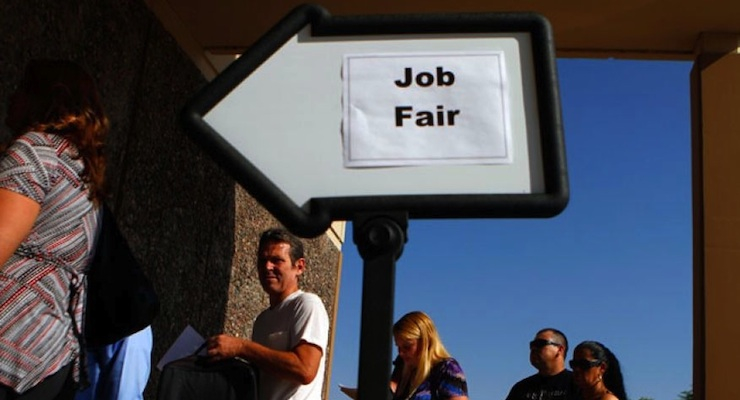

Unemployment Americans stand on a job fair line. (Photo: Reuters)
The Bureau and Labor Statistics June jobs report found the U.S. added 223,000 jobs in June and unemployment fell to 5.3%, according to the Labor Department. Analysts had predicted a gain of 230,000 jobs and that the unemployment rate would hold steady at 5.5%.
“Incorporating revisions for April and May, which decreased nonfarm employment by 60,000, monthly job gains have averaged 221,000 over the past 3 months,” BLS Commissioner Erica L. Groshen said in a statement. “In the 12 months prior to June, employment growth averaged 250,000 per month.”
While the headline unemployment rate and the number of jobs created remain important economic indicators, wage growth remained non-existent and the labor force participation remain fell to an abysmal 62.6%.
The civilian labor force declined by 432,000 in June on a seasonally adjusted basis, after actually gaining 397,000 in May.
“At this time of year, a large number of people move into and out of employment and unemployment,” Groshen said. “On a not seasonally adjusted basis, the net labor force gain in June was unusually low compared with prior years. As always, we caution against placing too much emphasis on one month’s data.”
The commissioner’s attempt to smooth over the data is admirable, but ultimately flawed. The month of June is not a one-off regarding labor participation and the employment-to-population ratio, the latter of which is at just 59.3%, nor can the drop be attributable to baby boomers exiting the workforce. While the Federal Reserve has named near full employment as one of its targets to hit before raising interest rates, they will parse the data a bit more closely than most economists commenting in the media.
The number of Americans employed part time for economic reasons — those would have preferred full-time employment, but were working part time because their hours had been cut back or because they were unable to find full-time work — ticked up to 6.5 million in June.
The Fed will be concerns over the lack of wage growth when trying to determining whether the U.S. economy has gained enough upward momentum to absorb the increase in borrowing costs that will accompany a rate hike. When rates are hiked, borrowing costs will increase for consumers looking to buy big ticket items, businesses looking to borrow money for expansion and capital improvements and the government looking to continue to borrow money for deficit spending.
The Fed is looking for 3% annual wage growth is needed to lift inflation to the central bank’s 2% target rate, the former of which we have not yet seen. In June, average hourly earnings for all employees on private nonfarm payrolls didn’t increase, at all. They were unchanged at $24.95, while average hourly earnings of private-sector production and nonsupervisory employees increased by just 2 cents to $20.99.
The Fed has been reluctant to raise rates for fear that prematurely raising borrowing costs could push the economy back into recession.





